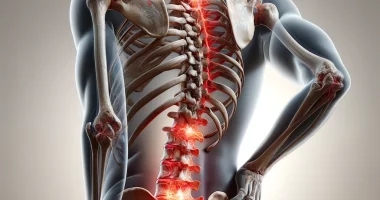Cerebral hemorrhage
Definition
Cerebral hemorrhage is a type of acute cerebral circulatory failure – the most common pathology in neurology. The development of cerebral hemorrhage is usually caused by untreated, persistent arterial hypertension, alcohol abuse, smoking, and taking drugs that interfere with blood coagulation. Diagnosis is made based on collecting the patient’s life history and conducting several examinations (MRI or CT, ECG). Treatment aims to eliminate brain edema and normalize respiratory function and blood pressure.
General information
Hemorrhage in the brain is a pathology that refers to a hemorrhagic-type stroke. Synonyms of this disease are ventricular hemorrhage (intraventricular hemorrhage) and hemorrhagic stroke with blood breakthrough into the ventricles. This pathology ranks among the highest mortality rates in the world.
According to medical statistics, cerebral hemorrhage is fatal in the first two days in 40-60% of cases. The percentage increases during the first year after a stroke, reaching about 90%. The development of hemorrhage is more characteristic of people over 50 years of age who suffer from persistent arterial hypertension but can also occur in other pathologies that are not associated with blood pressure indicators.
Classification
In clinical practice, neurologists distinguish three types of cerebral ventricular hemorrhage: hemorrhage in the lateral ventricles, in the III ventricle, and the IV ventricle.
Hemorrhage into the lateral ventricle occurs from adjacent brain tissue and is characterized by the gradual filling of the lateral ventricles with blood spreading into the III ventricle and beyond. With a large amount of spouted blood, brain volume significantly increases, and bilateral neurological symptoms develop. If hemorrhage is accompanied by the filling of only one lateral ventricle, it has a more favorable course and symptomatology resembling a normal parenchymatous hemorrhage.
Blood breakthrough into the III ventricle occurs from medial foci of parenchymatous hemorrhages. There is an acute development of neurological symptoms, often leading to death. Hemorrhage into the IV ventricle arises from the dorsal trunk or cerebellum. This type of hemorrhage is often fatal.
Causes
Brain ventricular hemorrhages are divided into primary and secondary hemorrhages. Primary ventricular hemorrhages associated with arterial hypertension or cerebral amyloidosis are rare. According to some observations, they account for 1 case in 300. Secondary hemorrhages are caused by such factors as uncontrolled use of antiplatelet and fibrinolytic drugs, intracranial aneurysm (local thinning and bulging of the cerebral blood vessel wall with subsequent rupture), oncologic neoplasms of the brain.
Hemorrhage into the ventricles of the brain is usually characterized by rapidly developing depression of consciousness. Coma often occurs in the first hours after the stroke. Only in the case of a gradual outpouring of blood and a small volume of blood can the patient’s consciousness be preserved for a long time and then lost gradually. As a rule, ventricular hemorrhage is accompanied by shell symptoms and vomiting. Vegetative symptoms are typical: hyperhidrosis and chills; pallor and then hyperemia of the face, limbs, and chest; initial decrease in temperature with a rapid change to hyperthermia reaching 41-42°C.
One of the typical signs of intracerebral ventricular hemorrhage is a disorder of muscle tone in the form of spastic seizuresor decerebration rigidity. In the first case, there is a seizure-like increase in muscle tone of the affected limbs. In decerebration rigidity, muscle tone is increased predominantly in the extensor muscles. The patient lies with his back arched and his head tilted back. His hands and fingers are flexed, forearms turned inward.
Often, cerebral ventricular hemorrhage is accompanied by paresis of the limbs opposite to the focus of hemorrhage, the appearance of motor automatisms in unaffected limbs, increased tendon reflexes, the presence of pathological and absence of abdominal reflexes, and pelvic organ dysfunction. With hemorrhage into the III ventricle, respiratory and circulatory disorders come to the fore, and spastic seizures are bilateral. Hemorrhage into the IV ventricle is accompanied by hiccups and swallowing disorders, spontaneous movements are absent, and the phenomena of spastic seizures are weakly expressed.
Continued hemorrhage into the ventricles due to an increase in the volume of blood, a sharp increase in intracranial pressure, increasing cerebral edema, and compression of nerve centers responsible for life support of the body exacerbate the symptoms of respiratory and cardiovascular disorders. Respiratory rhythm and respiratory rate are disturbed, short-term initial bradycardia is replaced by tachycardia up to 120-150 beats/min, and arrhythmia occurs.
Depending on the rate of ventricular hemorrhage, the patient’s condition worsens. The spastic seizures decrease, hypotonia gradually develops, automatic movements disappear, and cross pathological reflexes appear. Then full atonia and areflexia develop.
Diagnosis
The diagnosis of “cerebral ventricular hemorrhage” is made based on a systematic assessment of the patient’s history: the presence of blood diseases, previous hemorrhagic strokes, taking drugs that affect the blood coagulation system, etc., the acute onset and rapid development of severe clinical symptoms, the data of neurological examination and additional studies.
If cerebral ventricular hemorrhage is suspected, the patient should be taken to the hospital as soon as possible. To confirm the diagnosis, the patient will undergo an MRI or CT scan of the brain, blood tests with platelet count, coagulogram, ECG, and BP monitoring.
If an MRI or CT scan is impossible, the patient undergoes echoencephalography to determine whether the midbrain structures are displaced. In some cases, a lumbar puncture is required to differentiate intraventricular hemorrhage from ischemic stroke, in which blood enters the cerebrospinal fluid. A diagnostic ventricular puncture can more accurately diagnose cerebral ventricular hemorrhage.
Treatment and prevention
Treatment of cerebral ventricular hemorrhage, first of all, is aimed at the rapid organization of medical care and immediate implementation of primary therapy: normalization of cardiopulmonary function, control of blood pressure, and regulation of the constancy of the internal environment of the body. In addition, symptomatic treatment is carried out: administration of anticonvulsants if necessary, administration of agents to relieve cerebral edema and normalize intracranial pressure, and administration of antiemetics.
A precise specific therapy for cerebral ventricular hemorrhage aimed at stopping the bleeding is still under development. Pathogenetic therapy consists mainly of maintaining optimal BP and surgical evacuation of exuded blood.
The question of surgical treatment of cerebral ventricular hemorrhage is decided in each case separately. Evacuation of parenchymatous hematoma and puncture aspiration of blood from the ventricles can reduce intracranial compression and dislocation of brain structures. An indication for ventricular drainage or endoscopic evacuation of hematoma may be a medial stroke with ventricular rupture. Surgical intervention may be effective if there is evidence of an aneurysm or arteriovenous malformation of cerebral vessels. According to some clinical observations, surgical treatment is appropriate only in the first 6-12 hours when a coma develops.
In addition to the primary treatment, special attention is paid to the prevention of somatic complications – bedsores, respiratory distress syndrome, pneumonia, urogenital infection, and stress ulcers.
Prevention of acute hemorrhagic circulatory failure, including ventricular hemorrhage, is timely treatment of arterial hypertension, a healthy lifestyle, taking medications only as prescribed by a doctor, and timely detection and correction of diseases with blood clotting disorders.
All these treatment options are available in more than 510 hospitals worldwide (https://doctor.global/results/diseases/cerebral-hemorrhage). For example, Intracerebral hemorrhage (ICH) surgical treatment can be treated in 15 clinics across Turkey for an approximate price of $6.3 K(https://doctor.global/results/asia/turkey/all-cities/all-specializations/procedures/intracerebral-hemorrhage-ich-surgical-treatment).


